3. Playing with Sound and Music
So anyway, that’s how the features for playing with the cameras came together. At last, everyone had realised what the Nintendo DSi was going to be-its design, functions, and features. But then Miyamoto-san said something was missing.
I did? Oh…that’s right…
Music.
I myself wasn’t deeply involved in the actual development of the Nintendo DSi, but I’d been discussing it with Iwata-san for a long time, so it does have a special place in my heart. Quite a while back, I handed Iwata-san a list of what I thought the Nintendo DSi should accomplish. There was a lot on it, and as the actual specifications fell into place, the list gradually got smaller. Before I knew it, something I thought would still be there had disappeared.
Then one day, as the specifications were solidifying, I noticed the music request was gone. I said, “Hey, what happened to the music?” and they told me it could be downloaded later via DSi Shop. I couldn’t believe it! (laughs)
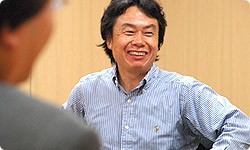
Development was already in its final stages. (laughs) It reminds me of how during the development of the Wii you squeezed in the Mii Channel at the last moment.
Everyone kept asking me, "Can’t we do it after release?" (laughs) I just thought it would be much better if it was there when people first opened the box.
You’re absolutely right. It makes a big difference as to whether everyone will try it out depending on whether it’s one of the standard internal features of the unit or something downloaded through DSi Shop. However, the reason DSi Sound wasn’t included from the start wasn’t just because of the lack of time. The developers had their reasons.
First of all, they thought users would be divided into those who would want to use a music player on their game console and those who wouldn’t, so it would be best if only those who wanted to could download it.
Another reason was that if someone really wanted to use a music player, it wouldn’t be any good to put in something sub-par like you often see. We needed ideas for something that couldn’t be viewed as incomplete, but there wasn’t near enough time to come up with them.
But about that time Miyamoto-san said, “Here are some of my ideas!” He said we could display vertical and horizontal axes for manipulating the pitch and playback speed using the stylus . When I heard that, I immediately thought that would be neat, so I ended up on the side causing everyone else trouble. (laughs) Before that I was on the defensive side, saying “No, it’s impossible!” (laughs)
(laughs)
You can have quite a lot of fun just changing the speed and pitch. You can change your mother’s voice to sound like an old man’s, and it’s good for copying guitar licks by ear and mastering conversational phrases in English. Basically, you can easily play around with it the way we used to play with tape recorders. That’s what I wanted to make.
And the one charged with making DSi Sound on such short notice was Yusuke Akifusa. Would you introduce yourself?
Ever since joining Nintendo, I’ve been working under Miyamoto-san, making software in the Software Development Department of the Entertainment Analysis and Development Division. I was in charge of creating the music player for what we call DSi Sound.
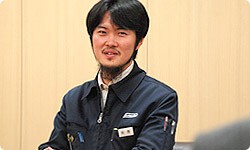
How did this project begin? We may be remembering this in a way too convenient to ourselves. Tell us how it really happened.
No, I think you’ve, uh, basically got it right.
(laughs)
It wasn’t so bad was it? You jumped at the chance, right?
Yes.
Really? (laughs)
It’s true. (laughs) I immediately thought, “This is something I should do.” But, um…I have to go back in the conversation a bit.
No problem. Go ahead.
Earlier, I had helped out with Big Brain Academy. At the same time, there was software called Brain Training. Big Brain Academy was a little different, and I realised lots of people were enjoying it. After that, at the time of the Wii release, I participated in the direction of Wii Play. At the same time, we also had Wii Sports. I think having both games out there at once was an extremely effective way to attractively present the Wii to the public.
This time, when I heard Miyamoto-san thought the DSi needed music, it kicked off my own train of thought. I thought, we’ve already got the cameras as one important pillar, so why not institute music as another one, reinforcing the appeal of the Nintendo DSi?
Oh, so that’s how you looked at it.
Yes. I thought it would be good if the camera and music features of the Nintendo DSi fulfilled the role of expanding its appeal the way Wii Sports and Wii Play did for the Wii.
I see.
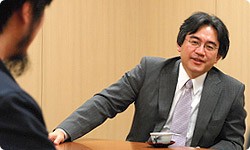
So first I went around the company gathering information on the progress being made toward having the Nintendo DSi play music, and relayed it to Miyamoto-san. I listened to what he envisioned regarding software for playing with music and sound, and then spread that around the developers. I did that using my own initiative, so I think that’s what he means when he says I jumped at the chance.
I think it’s an accurate description.
(laughs)
I just figured that if we were going to do it, there wasn’t a moment to lose.
(laughs)
While I was dashing around doing that, before I knew it, the project had taken off. When I look back at it now, that’s how it seems.
At first I was worried about the late start, but then part of the way through I added one big specification.
Yes (laughs), you did.
It’s just, the DS has a microphone! (laughs) What good is it if you can’t record anything?
(laughs)
So I asked that users be able to play around with their voices. I asked Miyamoto-san about it, and he said the idea had been raised, but we were coming down to the wire, so he didn’t think there was any way he could accommodate such a beastly demand.
Right. I just couldn’t do it!
(laughs)
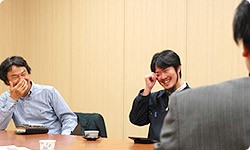
What I suggested was that if you’re going to make recordings, you could use your voice or other sounds as start-up sounds when you turn on the power and so on.
And that idea leapt into Matsushima-san’s work. (laughs)
Unfortunately, he pretended he hadn’t even heard that idea…
Th-That’s not true! (laughs)
Ha ha ha ha!
But because of the schedule, we were in a real bind. As much as possible, we wanted to fill up the DSi menu with appealing aspects of the hardware and the internal software, but the timing was...
Yes, we didn’t decide to put in sound tools until the very end. The menu is a core program. You can’t ever be sure where and how it will have an effect, so you can’t make changes at the very end. The various applications are relatively peripheral, so you can make adjustments up to the very end.
We talk about suddenly adding DSi Sound, so people might think we just threw it in in a burst of enthusiasm, but it’s not really so. Nintendo has a proper sound team and each of its members perform multiple tests in compression and editing. Akifusa-san’s flurry of activity was able to bring something to shape because he could gather the already-existing sound technology and channel it into the DSi. All at once he brought together the sound technology being developed by other teams around the company.
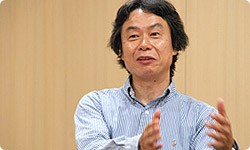
A completely different team within the company was performing some sound tests, and Akifusa-san said, “Why don’t you use this?”
Right. As we were considering which technology to use, Iwata-san got involved, and a new element was presented to us.
Oh, that’s right. A completely unrelated team was making a game using sound. I said it looked fun and told them to take it to Miyamoto-san.
And we thought, “All right, we’ll take this! Thanks!”
I’m sure Akifusa-san was spinning in circles, in a good way, but once I decide to do something, I can be very mean, too. (laughs) I’d like you to explain how it turned out, but it’s hard to put into words, isn’t it?
Yes, it is. (laughs) The easiest way to understand it is to use it. Basically, when you record a word, you can play with it the way you might a music file, such as by changing the pitch or speed-so it sounds really high, for example – or making it sound like it’s gone through a voice changer . Also, you can play your recordings backwards , and save the sounds that you have reworked.
And you can simply listen to music, right?
Of course! We dedicated ourselves to usability so, as a music player, it would be as simple and easy to understand as possible. You can also repeat specific parts of the music you’re listening to , so it’s also a useful tool for practising musical instrument and vocal parts. And it’s perfectly suited to English conversation lessons.
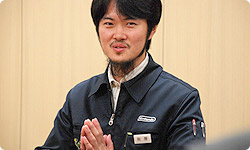
Being able to repeat specific sounds isn’t all that rare, but that’s where the touchscreen comes in. When you think about how you can carry it around, you realise how handy it can be.
Yeah. You can also play around with filters on songs. For example, you can make it sound grainy like its coming from an old radio, make it echo, or turn it into eight-bit sound like with the old NES . And - just for fun - you can take your own voice as you’ve recorded or altered it and inject it into the middle of a song.
(laughs)
Also-and this is another idea that came from a different in-house team – you can play drums in time with music . The L Button is your bass drum and the R Button, your snare. As you listen to the music, you can be all boom bap bap!
There’s so much you can do that it’s hard to imagine we didn’t have much time! (laughs) On a side note, those who have seen the graphics might wonder why Super Mario Bros. shows up on the sound screen.
Oh, well we used those ups and downs with coins to represent the fluctuations in the music’s sound.
How clever! (laughs)
Are you sure there wasn’t much time? (laughs)
Well, that’s a good question. The reason we were able to accomplish all this in such a short time is that staff from all over the company, real veterans and aces from various fields, all lent a hand.
We have Miyamoto-san to thank for that.
Well, I had made some impossible requests time-wise, so full support from the best of our staff was necessary.
(laughs)
So with regard to making the sound application, there was hardly any reason to worry.